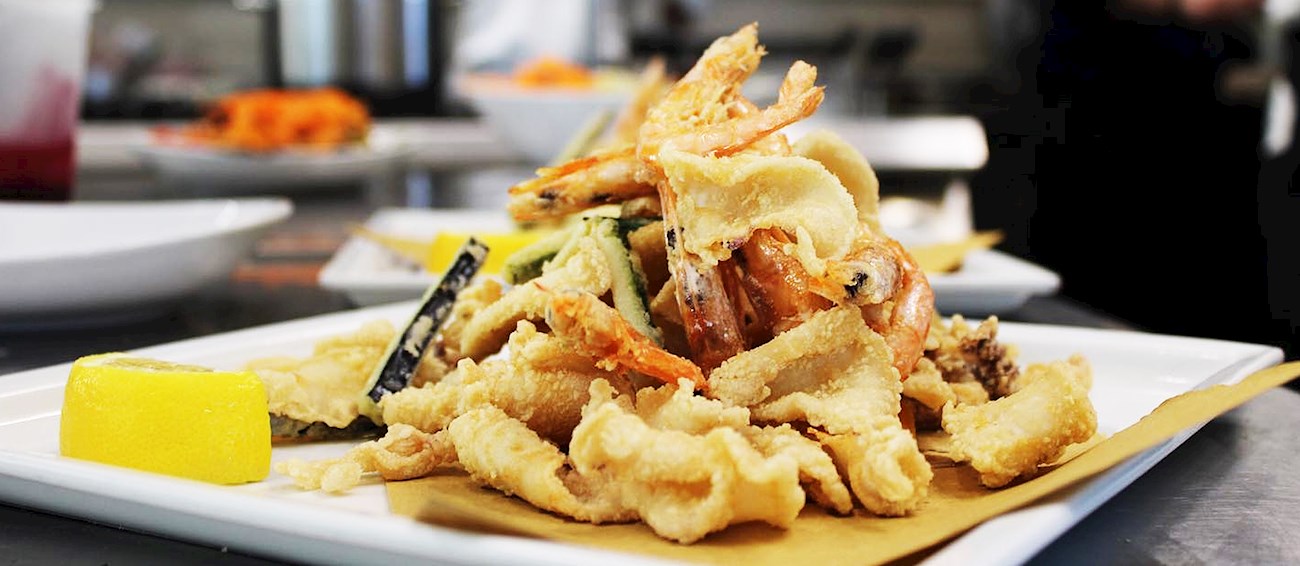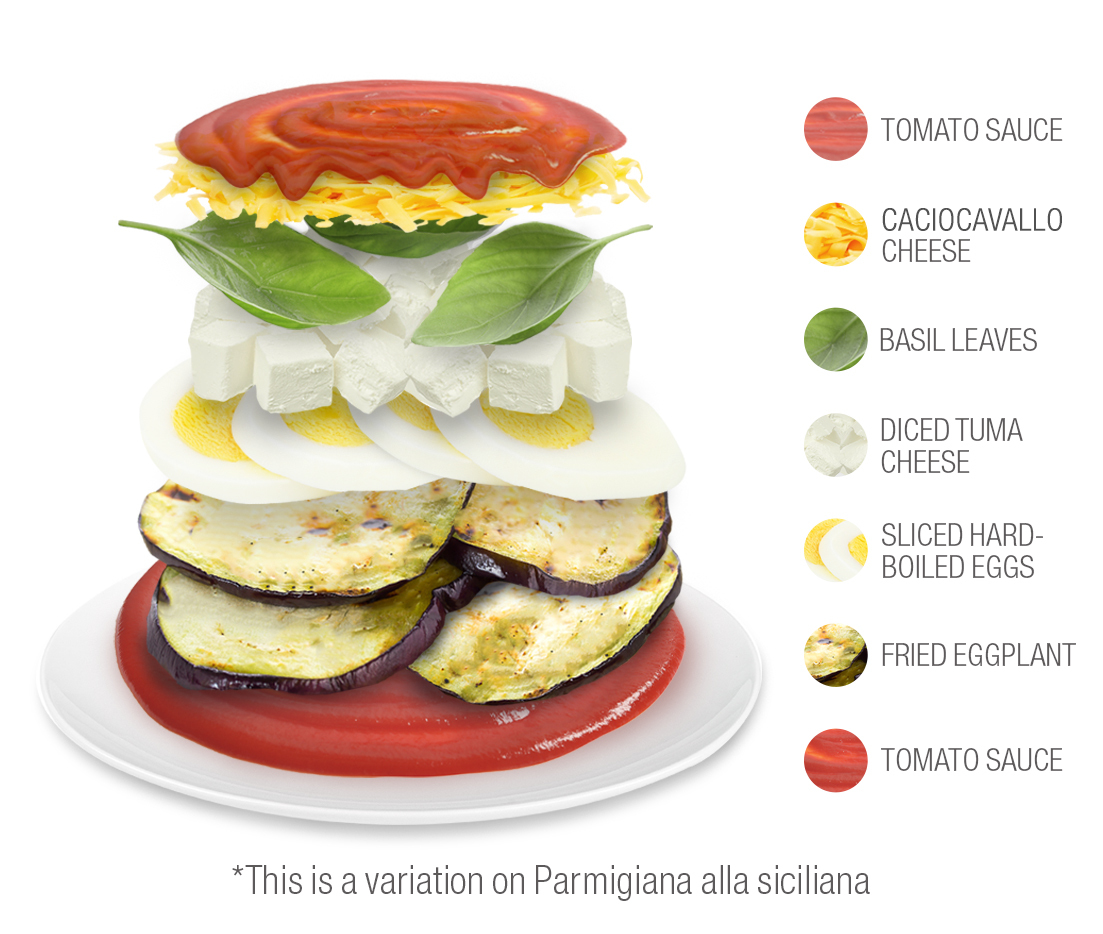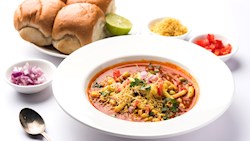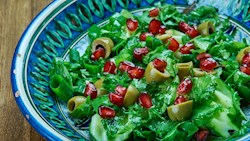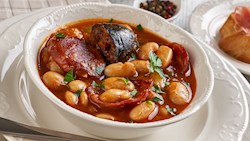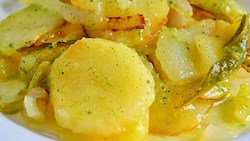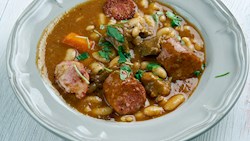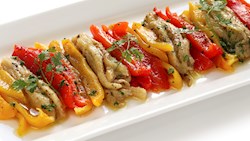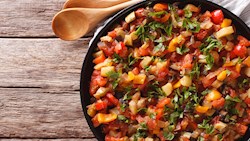Found throughout southern Italy, parmigiana di melanzane is a type of gratinated vegetable casserole traditionally made of fried or grilled slices of eggplant layered with basil-flavored tomato sauce and topped with one or more cheeses, such as mozzarella, pecorino Siciliano, scamorza, and caciocavallo Silano.
Contrary to popular belief, parmigiana has nothing to do with parmigiano Reggiano cheese, even though it is used in many recipes as it makes for a crunchier crust. Nor, in fact, does it have any connection with the city of Parma whatsoever. In fact, the name of this scrumptious summer dish supposedly stems from parmisciana, the word for “Persian” in the Sicilian dialect, and it is often suggested that the word is rooted in the Arabic badhnajan or Turkish patlıcan, both of which mean “eggplant”.
VARIATIONS OF Parmigiana
MOST ICONIC Parmigiana
View moreMAIN INGREDIENTS
Fritto misto is one of those dishes that differs widely across the country. Along the Italian seaside, it will always include crustaceans and mollusks, typically shrimp and squid, and often paranza, which is a collective name for very small whole fish such as fresh anchovies, sardines, baby mackerel, or mullet.
In northern parts of the country, particularly in Piedmont, fritto misto is mostly made with vegetables and, depending on the season, includes semolina, veal brain, brochettes of cheese and prosciutto, sometimes even apples and amaretti biscuits.
VARIATIONS OF Fritto misto
MOST ICONIC Fritto misto
View moreMAIN INGREDIENTS
This version of eggplant parmigiana is the most popular outside of Italy. Hailing from Campania, this variation on a dish is made with eggplants, olive oil, onions, basil, tomatoes, mozzarella or fior di latte cheese, and grated Parmigiano-Reggiano.
The eggplants are peeled, sliced, and shortly fried, then arranged in a baking dish over the tomato sauce along with the cheese, basil leaves, and grated Parmigiano-Reggiano. The layers are repeated, and the final one should end with tomato sauce and grated cheese.
Tarascan puréed bean soup hails from the Mexican state of Michoacán, home of the Tarascan or Purépecha people — one of the major pre-Columbian civilizations of Mesoamerica. Their culture flourished from 1100s to the early 1500s, but by the 1530, Purépecha people had succumbed to the Spanish conquistadors who eventually named them Tarascos, hence the name sopa Tarasca.
Apart from the beans — which are usually cooked together with tomatoes in a simple chicken broth — this dish is a great source of both fresh and dried chili peppers, most of which are native to the New World like the smoked pasilla de Oaxaca, which imparts not only a delicate heat but also adds a nice smoky flavor to this hearty soup.
MAIN INGREDIENTS
Diri ak pwa, also called diri kole ak pwa, is the national dish of Haiti, consisting of rice and beans. The dish became a common, everyday staple during the period of slavery, when rice and beans were two of the few ingredients that were fed to the slaves by their owners.
It can be made with a variety of beans, but pinto, red kidney beans, and black beans are the most common options. Diri ak pwa is exceptionally nutritious as rice is rich in starch and contains iron, vitamin B, and protein, while the beans also contain iron and a greater amount of protein than rice.
Dal tadka or tadkewali dal is a traditional legume-based dish originating from the northern parts of India. Although there are variations, the dish is usually prepared with toor dal (split yellow pigeon peas), garlic, ginger, onions, tomatoes, garam masala, chili peppers, ghee, cumin, coriander, turmeric, red chili powder, and fenugreek leaves.
These ingredients are cooked and mixed with tadka (tempering), consisting of spices such as asafoetida, chili peppers, and garlic that are cooked in ghee. Once prepared, dal tadka is usually garnished with coriander leaves and served hot with jeera rice and roti on the side.
MAIN INGREDIENTS
Yemista or gemista is a Greek dish traditionally consisting of vegetables such as tomatoes and green peppers that are stuffed with rice and vegetables' inner parts. The stuffed vegetables are then baked in the oven. The name of the dish means stuffed in Greek language, and it's a typical summer dish.
It is mainly considered a vegan dish, although there are some that prepare it with ground meat in the stuffing. It is recommended to prepare the dish when the vegetables are at the peak of the season and to serve it garnished with a spoon of Greek strained yogurt and accompanied by feta cheese.
MOST ICONIC Yemista
View moreMAIN INGREDIENTS
Feijão tropeiro is a traditional dish from the Brazilian state of Minas Gerais. A favorite dish of cattle rangers (tropeiros), it consists of beans that are cooked with salted or dried meat, manioc flour, and various flavorings, herbs, and vegetables.
Today, there are numerous variations on the dish, so the type of beans and meat vary from one part of the country to the next. It is believed that the dish was invented during the Brazilian Colonial period, when tropeiros used to sell things while traveling on horses, bringing beans, manioc flour, and dried meat with them on long journeys.
MOST ICONIC Feijão tropeiro
View moreMalai kofta is a traditional North Indian dish consisting of fried potato and paneer balls in a creamy sauce. The dish is commonly served at festivals, celebrations, and weddings due to its rich texture and flavors. A typical dish of Mughal cuisine, developed in Medieval India by the cooks of the Mughal Empire, it is essentially a vegetarian substitute for a meatball curry, malai meaning cream, and kofta meaning dumplings.
The dish is often prepared in a unique wok called a kadai, hence the other name of the dish, kadai kofta. Some food historians believe that these deep-fried dumplings have incorporated the influences of Turkish and Persian food cultures within them.
Misal is a specialty dish of the Indian state of Maharashtra, its name literally translated to a mixture of everything, so the ingredients vary from cook to cook. However, a combination of these ingredients is the most common in a typical misal: curd, moth bean or pea curry, gravy, spiced potatoes, and garnishings such as onions, coriander, and tomatoes.
It is mandatory for a true misal to be spicy, while the base needs to be crunchy. Visually, it should look like a work of art, with lots of colors - typically red, brown, orange, and green. The earliest mention of the dish appeared around the early 20th century.
MOST ICONIC Misal
View moreTasteAtlas food rankings are based on the ratings of the TasteAtlas audience, with a series of mechanisms that recognize real users and that ignore bot, nationalist or local patriotic ratings, and give additional value to the ratings of users that the system recognizes as knowledgeable. For the “Top 100 Vegetable Dishes in the World” list until March 20, 2025, 18,878 ratings were recorded, of which 10,667 were recognized by the system as legitimate. TasteAtlas Rankings should not be seen as the final global conclusion about food. Their purpose is to promote excellent local foods, instill pride in traditional dishes, and arouse curiosity about dishes you haven’t tried.
